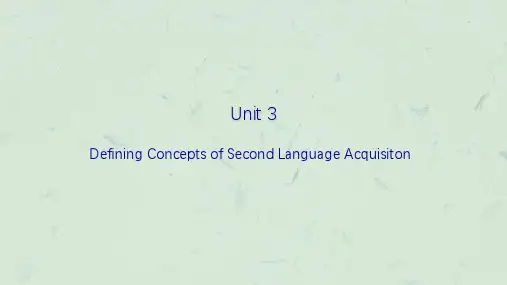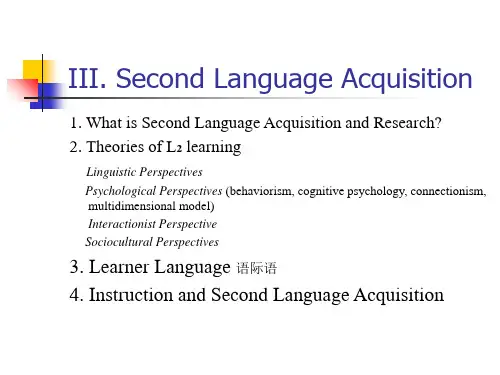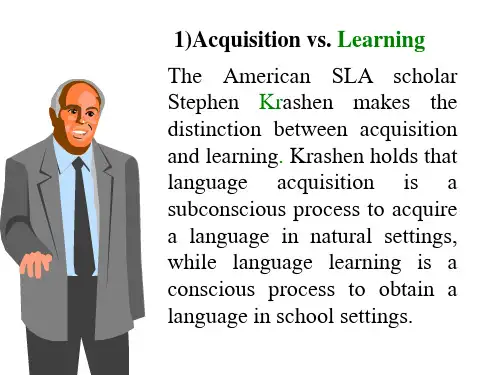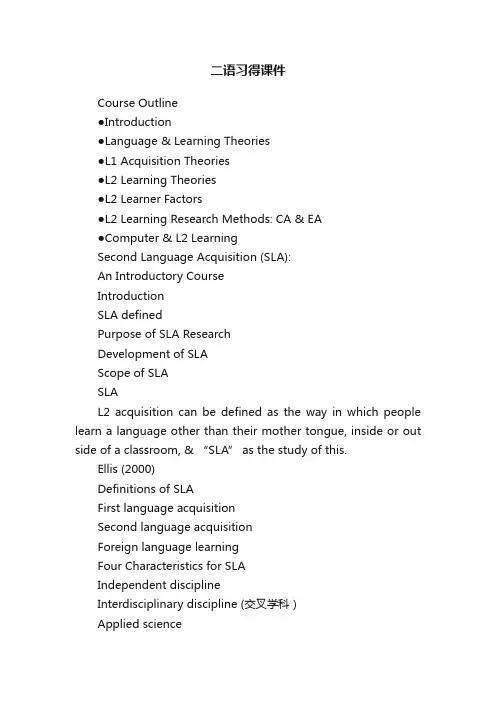二语习得入门英语课件
- 格式:ppt
- 大小:135.00 KB
- 文档页数:28





二语习得课件Course Outline●Introduction●Language & Learning Theories●L1 Acquisition Theories●L2 Learning Theories●L2 Learner Factors●L2 Learning Research Methods: CA & EA●Computer & L2 LearningSecond Language Acquisition (SLA):An Introductory CourseIntroductionSLA definedPurpose of SLA ResearchDevelopment of SLAScope of SLASLAL2 acquisition can be defined as the way in which people learn a language other than their mother tongue, inside or out side of a classroom, & “SLA” as the study of this.Ellis (2000)Definitions of SLAFirst language acquisitionSecond language acquisitionForeign language learningFour Characteristics for SLAIndependent disciplineInterdisciplinary discipline (交叉学科)Applied scienceEmpirical science (实证)Four Criteria for an independent disciplineOwn object of studyOwn theoriesOwn researchersOwn methodologiesDevelopment of SLAGrowthMaturationFurther developmentScope of SLAEllis? scope of research areaRole of SLA researchmediatorengineer4 areas (Ellis 1994)3 Areas (Wen & Wang 2004)Scope of SLA (Doughty 2003)Acquisition and loss ofsecond/third languages,dialects,foreign languages, lingua francaBy children and adultsNaturalistic/instructedIndividuals/groupsWhy Study SLA? What ?Testing theoriesCatering language-learning needschapter 1.pptSLA: Second Language Acquisitionsla introduction.ppt“Second” vs. “foreign” language acquisitionIn the case of “Second” langu age acquisition, the language plays an institutional & social role in the community—it functions as a recognized means of communication among members who speak some other language as their mother tongue.Second Language AcquisitionFor example, English as a second language is learnt in the US, UK & countries in Africa such as Nigeria (尼日利亚) & Zambia.Second v. foreignIn contrast, “foreign” language learning takes place in settings where the language plays no major role in the community & is primarily learnt only in the classroom. Examples of foreign language learning are English learnt in China,France or Japan.Second Language AcquisitionIn the broad sense, “second”can refer to any language that is learned subsequent to the mother tongue. Thus, it can refer to the learning of a 3rd or 4th language. Also, “second” is not intended to contrast with “foreign”.Whether you are learning a language naturally as a result of living in a country where it is spoken (naturalistic or spontaneous), or learning it in a classroom through instruction(instructed or guided), it is customary to speak generically of “second” language acquisition. ?L2 acquisition can be defined as the way in which people learn a language other than their mother tongue, inside or outside of a cla ssroom, & “Second Language Acquisition” (SLA) as the study of this.S L ASLA took place around the end of the 1960s, developed in the 1970s or even early 1980s. ?SLA is a complex, multifaceted(多方面的)phenomenon & it’s not surprising that it has come to mean different things to different people.Competence v. performanceAccording to Chomsky (1965) Competence consists of the mental representations of linguistic rules that constitute the speaker-hearer’s internal grammar.Performance consists of the use of this grammar in the comprehension & production oflanguage.Communicative C o m p e t e n c e v.p e r f o r m a n c e ?Communicative Competence includes both linguistic & pragmatic knowledge (knowledge the speaker-hearer has of what constitutes appropriate as well as correct language behavior & also of what constitutes effective language behavior in relation to particular communicative goal.Communicative performance ?Communicative performance consists of the actual use of these two types of knowledge in understanding & producing discourse.Usage v. UseAccording to Widdowson (1978):Usage is “that aspect of performance which makes evident the extent to which the language user demonstrates his knowledge of linguistic rules ”.We study usage if we focus attention on the extent to which the learner has mastered the formal properties of the phonological, lexical, & grammatical systems.Usage v. UseUse is that aspect of performance which “makes evident the extent to which the language user demonstrates his ability to use his knowledge of linguistic rules for effectivecommunication”.We study use if we examine how learners convey meaning through the process of constructing discourse.Usage v. Use由威德森提出的一种区分方法,一个语言项目如作为语言系统中的一个成分,其功能成为语言系统中的用法(usage),如果是作为交际系统中的一部分,则其功能成为具体用法(use)。





